A Conversation with Sally Kauffman
Chill Out: Paintings by Sally Kauffman
Artist Talks: November 20, 2019, 5-7PM
Forum Gallery: Schlesinger Arts Center
Northern Virginia Community College – Alexandria Campus
When did you know that you were an artist?
As a child I would sequester myself in a secret spot and draw for hours.
Was there a particular experience that inspired your decision to pursue art?
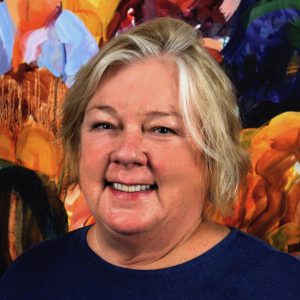 My grandmother taught me to draw and paint as a young girl. One of my favorite memories is sitting by her side watching her paint with watercolors. Her life inspired my own. She was a magical, mystical woman who entertained her family with lavish meals during holidays, especially at Christmas when she dressed as Mrs. Klaus.
My grandmother taught me to draw and paint as a young girl. One of my favorite memories is sitting by her side watching her paint with watercolors. Her life inspired my own. She was a magical, mystical woman who entertained her family with lavish meals during holidays, especially at Christmas when she dressed as Mrs. Klaus.
She owned and operated a therapeutic spa for women as well as an art practice. She painted wonderful images of nature and people. She taught me that I could be whatever I wanted to be.
Are there particular artists or art movements that are an inspiration to you?
Movements and painters amongst the many that influenced my practice from early on include Ukiyo-e artist Hokusai, Venetian School painters Titian, Tintoretto and Veronese, Les Nabis artists Bonnard and Vuillard and Fauvist Matisse. Abstract Expressionism was and remains a major influence. De Kooning, Frankenthaler, Rothko, Pollock, Raushenberg, Johns, Twombly, Mitchell, Krasner, I can’t think of any who did not influence my work. Bay Area Figurative painter Diebenkorn was a revelation to me. Contemporary movements and artists that I currently look at are the YBA (Young British Artists) Cecily Brown, Jenny Saville, Rachel Whiteread and Tracey Emin among many others as well as South African artist Marlene Dumas.
Can you describe your artistic process?
To create the series “Relaxed States” which includes the exhibition “Chill Out”, I discreetly captured images of groups of people lounging and relaxing together using my phone camera. I create digital sketches from the photos by collaging elements and enhancing the color to create a visually dense image. The saturated digital color informs my palette. I mix oil paint and oil painting mediums into a fluid, smooth consistency in small jars, then brush blocks of transparent color directly on the canvas building up multiple layers that afford me flexibility in defining the position and form of the elements. As the forms evolve I respond to the images on the canvas and only reference the digital sketch if I find the need for the original images to inform my own.
Can you talk about how you use visual technologies (computers and software) with your artistic process?
I limit the use of software tools in my creative process to my iPhone and image processing software including Preview, iPhoto and Gimp, all free or shipped with my Mac even though I used many sophisticated tools for 25 years in the tech industry as a user experience designer, graphic designer and art & design director. I’ve resisted integrating digital technology into my art even though I am still fascinated by it, I’m seeking an escape from designing simulated environments and want to live again in the physical world using tangible tools. A good day is when I come home from the studio with paint in my hair and on my face and hands. I use digital tools to create digital sketches in the conceptual phase using snapshots with my iPhone and manipulating the images on the computer. I print the sketches and use them as a reference. The final artwork is produced by hand with paint and canvas.
You have four paintings in the exhibition that were inspired by the summer jazz concerts at the National Gallery in Washington DC. Can you tell us about that experience and what made you want to explore the experience in paint?
 The long answer: after a 20 year hiatus from painting while I worked in the tech industry, I needed inspiration as I resumed my painting practice so I enrolled in a class called “Painting in a Series” at the Corcoran taught by Judy Southerland. Judy reviewed my work and asked me what I was going to paint. I did not know so she gave me a written exercise titled “What Matters” in which you described an activity you care about and how it affects you and others, a social system that interests you and your stance in relation to this system and a condition or question that interests you. I filled it out but still it was unclear to me. So I turned to my private life. My husband and I love to cook and entertain our friends so I started photographing and painting my dinner parties. Out of this grew a series of work centered on groups of people sharing food, swimming and listening to music.
The long answer: after a 20 year hiatus from painting while I worked in the tech industry, I needed inspiration as I resumed my painting practice so I enrolled in a class called “Painting in a Series” at the Corcoran taught by Judy Southerland. Judy reviewed my work and asked me what I was going to paint. I did not know so she gave me a written exercise titled “What Matters” in which you described an activity you care about and how it affects you and others, a social system that interests you and your stance in relation to this system and a condition or question that interests you. I filled it out but still it was unclear to me. So I turned to my private life. My husband and I love to cook and entertain our friends so I started photographing and painting my dinner parties. Out of this grew a series of work centered on groups of people sharing food, swimming and listening to music.
The paintings in the exhibition were inspired by evenings spent sitting in the National Sculpture garden listening to jazz surrounded by the fascinating people who live in DC. I wanted the paintings to celebrate and exude the kind of energy and pleasure that you would find in Manet’s “Le Dejeuner sur l’herbe” and Titian’s painting “The Bacchanal of the Andrians”.
What about your strolls through Porto inspired you? The color and light in the two series of works is very different. How do you use color and light to create the atmosphere in your paintings?
 I visited the Passeio Das Virtudes during the “golden hour” which is the first or last hour of sunlight in a day when the light is soft and warm and the shadows long. This combination of warm colors contrasted with darker cool color defines my typical palette and explains my attraction to the scene.
I visited the Passeio Das Virtudes during the “golden hour” which is the first or last hour of sunlight in a day when the light is soft and warm and the shadows long. This combination of warm colors contrasted with darker cool color defines my typical palette and explains my attraction to the scene.
The paintings inspired from the “Jazz in the Garden” depict the warmer light just before the golden hour. I’m fascinated by paintings that create drama using chiaroscuro, the strong contrast of light or lack of it to define volume in form. Diebenkorn and Hopper’s use of chiaroscuro in their paintings is a good example of this and of course, Caravaggio was the master.
What is that you would like the viewer to take away from their experience of seeing this exhibition?
A collector of a painting in this series recently wrote to me “every time we look at your piece of art we are more delighted.” That is one of the most satisfying aspects of my art practice.
Is there any advice that you would give students as they have made the decision to pursue art?
Define what you want your art practice to be and treat your practice as a profession. This can and will change over time as you mature as an artist and a person. Schedule time for your practice and stick to it even if it involves sitting in your studio and staring at the walls, this is critical to your development. Build a network of your peers by attending local exhibitions and introducing yourself to the artists and gallery owners. Once you have built up that network support your artist friends by attending their art events. Define a social media strategy for yourself. Attend the free lectures at the Smithsonian. Read Art/Work = Everything You Need to Know (and Do) As You Pursue Your Art Career. Rent a studio that hosts open studios and will expose you to other artists and collectors.
To kickstart my art practice after a long hiatus, I studied at the Corcoran in the evenings for 3 years with Judy Southerland who become a mentor for me. (find a mentor) The artists I met in her class are now my peers. I rented studios through which I met different groups of artist friends. I also joined the Studio Gallery, the longest running artist coops in DC, while I had another full-time job. Scheduled annual shows taught me how to prepare and install an exhibit. I learned that I needed to paint when I really didn’t have time or feel like it and how to market my work. I served on the board and learned how to run a gallery. And made more artist friends. I applied for and attended an artist residency at Vermont Studio Center and met an international group of artists. Your network is going to be very important to you. They will expose you to new opportunities and will enrich your practice and life.
What can we expect from your work in the future?
I’m embarking on a big adventure in January. I’m moving to Rome for a year. There are so many things I want to do while I’m there, I’ll be taking workshops, spending lots of time in the museums and galleries and soaking it all in. I’m hoping it will take my work in new directions.
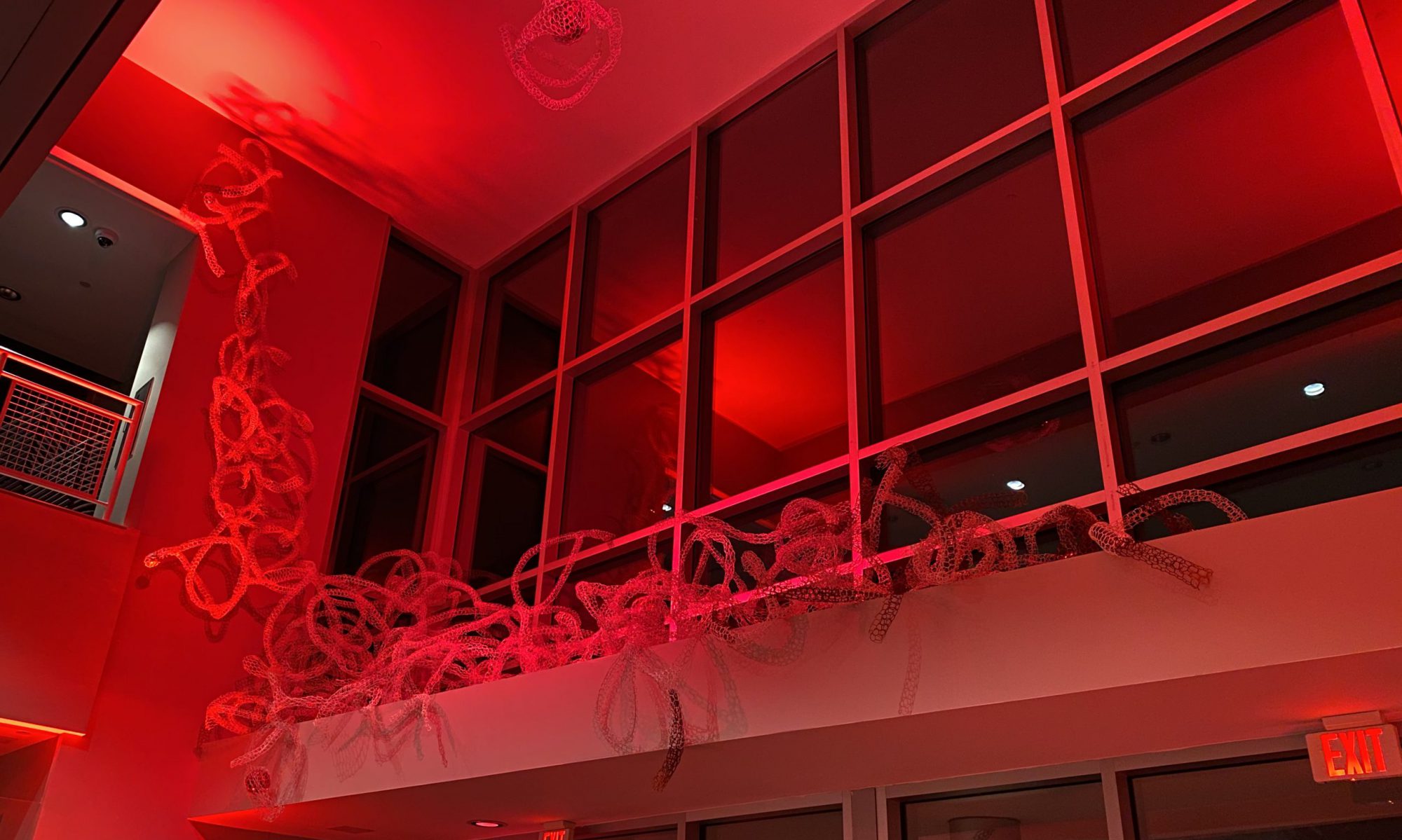
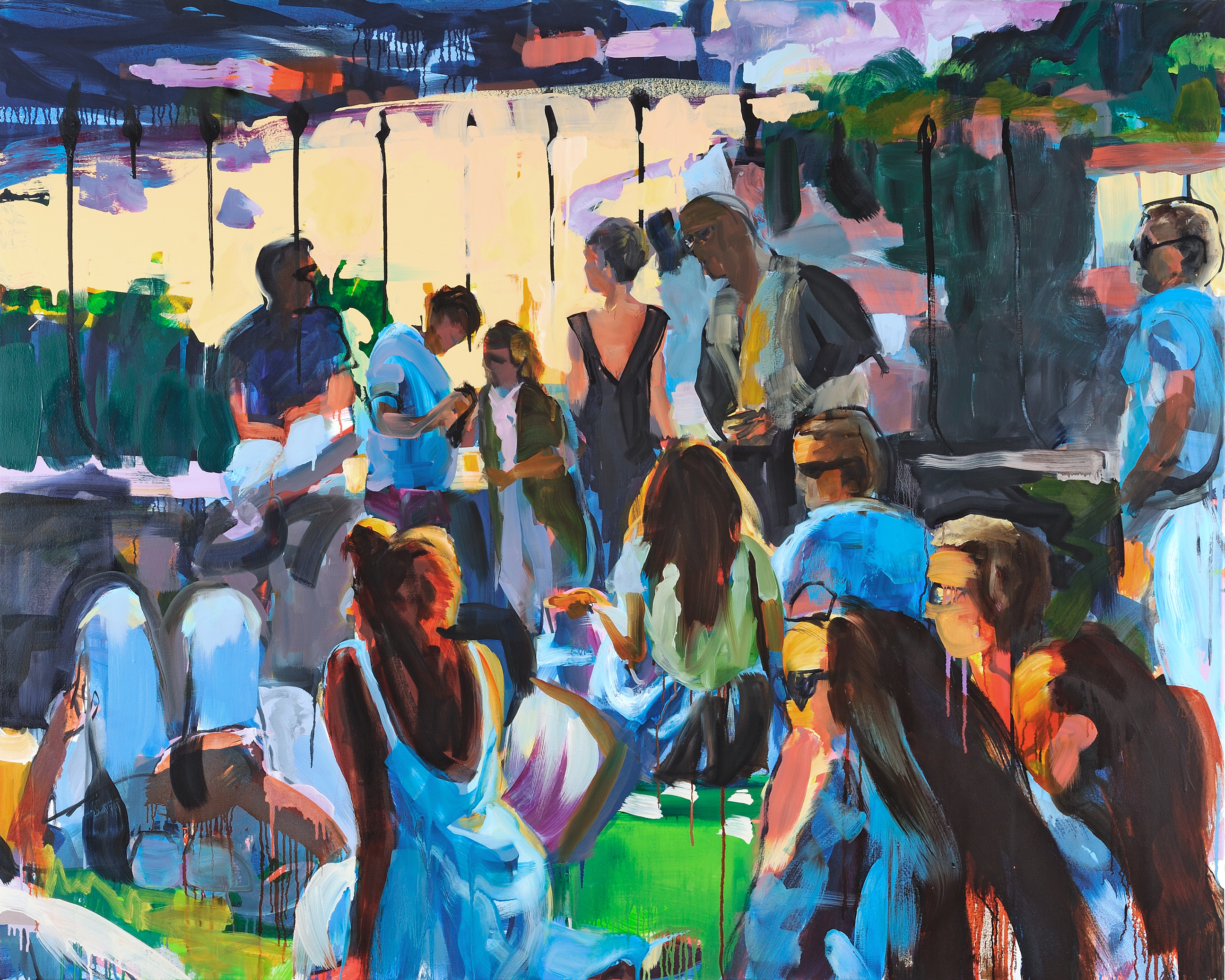
 My grandmother taught me to draw and paint as a young girl. One of my favorite memories is sitting by her side watching her paint with watercolors. Her life inspired my own. She was a magical, mystical woman who entertained her family with lavish meals during holidays, especially at Christmas when she dressed as Mrs. Klaus.
My grandmother taught me to draw and paint as a young girl. One of my favorite memories is sitting by her side watching her paint with watercolors. Her life inspired my own. She was a magical, mystical woman who entertained her family with lavish meals during holidays, especially at Christmas when she dressed as Mrs. Klaus. The long answer: after a 20 year hiatus from painting while I worked in the tech industry, I needed inspiration as I resumed my painting practice so I enrolled in a class called “Painting in a Series” at the Corcoran taught by Judy Southerland. Judy reviewed my work and asked me what I was going to paint. I did not know so she gave me a written exercise titled “What Matters” in which you described an activity you care about and how it affects you and others, a social system that interests you and your stance in relation to this system and a condition or question that interests you. I filled it out but still it was unclear to me. So I turned to my private life. My husband and I love to cook and entertain our friends so I started photographing and painting my dinner parties. Out of this grew a series of work centered on groups of people sharing food, swimming and listening to music.
The long answer: after a 20 year hiatus from painting while I worked in the tech industry, I needed inspiration as I resumed my painting practice so I enrolled in a class called “Painting in a Series” at the Corcoran taught by Judy Southerland. Judy reviewed my work and asked me what I was going to paint. I did not know so she gave me a written exercise titled “What Matters” in which you described an activity you care about and how it affects you and others, a social system that interests you and your stance in relation to this system and a condition or question that interests you. I filled it out but still it was unclear to me. So I turned to my private life. My husband and I love to cook and entertain our friends so I started photographing and painting my dinner parties. Out of this grew a series of work centered on groups of people sharing food, swimming and listening to music. I visited the Passeio Das Virtudes during the “golden hour” which is the first or last hour of sunlight in a day when the light is soft and warm and the shadows long. This combination of warm colors contrasted with darker cool color defines my typical palette and explains my attraction to the scene.
I visited the Passeio Das Virtudes during the “golden hour” which is the first or last hour of sunlight in a day when the light is soft and warm and the shadows long. This combination of warm colors contrasted with darker cool color defines my typical palette and explains my attraction to the scene.
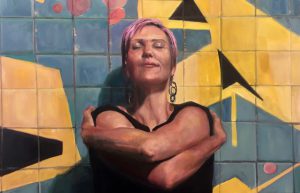

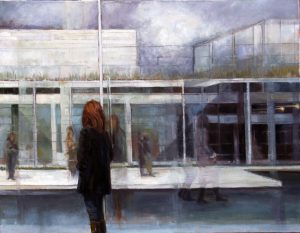 Cathy Abramson’s oil paintings investigate the stories of the city. These representational paintings examine the emotional subtext of change; the connections or estrangement of people in transitional neighborhoods. She sees moments of poetry in the ordinary. Although she paints particular people and scenes, these paintings about daily life in Washington, DC resonate with everyone. Cathy spent two years investigating and painting the neighborhood and people around Kennedy Street, NW. She recorded scenes that are about recent history, change, nostalgia and social struggle; the joys and frustrations of contemporary urban life.
Cathy Abramson’s oil paintings investigate the stories of the city. These representational paintings examine the emotional subtext of change; the connections or estrangement of people in transitional neighborhoods. She sees moments of poetry in the ordinary. Although she paints particular people and scenes, these paintings about daily life in Washington, DC resonate with everyone. Cathy spent two years investigating and painting the neighborhood and people around Kennedy Street, NW. She recorded scenes that are about recent history, change, nostalgia and social struggle; the joys and frustrations of contemporary urban life.

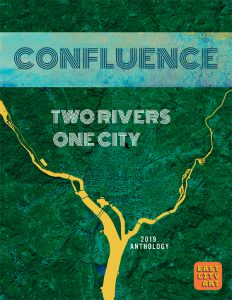 East City Art, DC’s visual arts publication of record, has released its second annual anthology of critical writing titled CONFLUENCE: Two Rivers One City. The 30 essays of the anthology present some of East City Art’s most compelling writing and document the DC region’s most prominent influences on regional visual arts culture.
East City Art, DC’s visual arts publication of record, has released its second annual anthology of critical writing titled CONFLUENCE: Two Rivers One City. The 30 essays of the anthology present some of East City Art’s most compelling writing and document the DC region’s most prominent influences on regional visual arts culture. Phil Hutinet, a third generation Capitol Hill resident, is the publisher of East City Art, DC’s Visual Arts publication of record, which he began in 2010. In 2012-2013, his consultancy work east of the river yielded the Anacostia Playhouse, Craig Kraft Studios, the Anacostia Arts Center and the 2012-2013 LUMEN8ANACOSTIA festivals. In 2015, 2018 and 2019 he acted as the Gateway Open Studio Tour coordinator. From 2013-2018, he produced EMULSION, East City Art’s regional juried show and has produced over 150 local exhibitions in his career as a gallery owner and director. Currently, he oversees the ECA Foundation’s Critical Arts Writing and Research Program which produces an annual anthology titled CONFLUENCE: Two Rivers One City. Hutinet has been interviewed by or has made appearances on the BBC, Capital Community News, Euronews, Washingtonian Magazine, Washington City Paper, The Washington Post, WJLA ABC News Channel 7/Channel 8, WTOP and other local, national and international media.”
Phil Hutinet, a third generation Capitol Hill resident, is the publisher of East City Art, DC’s Visual Arts publication of record, which he began in 2010. In 2012-2013, his consultancy work east of the river yielded the Anacostia Playhouse, Craig Kraft Studios, the Anacostia Arts Center and the 2012-2013 LUMEN8ANACOSTIA festivals. In 2015, 2018 and 2019 he acted as the Gateway Open Studio Tour coordinator. From 2013-2018, he produced EMULSION, East City Art’s regional juried show and has produced over 150 local exhibitions in his career as a gallery owner and director. Currently, he oversees the ECA Foundation’s Critical Arts Writing and Research Program which produces an annual anthology titled CONFLUENCE: Two Rivers One City. Hutinet has been interviewed by or has made appearances on the BBC, Capital Community News, Euronews, Washingtonian Magazine, Washington City Paper, The Washington Post, WJLA ABC News Channel 7/Channel 8, WTOP and other local, national and international media.”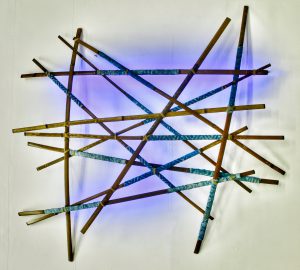 We pleased to present work from two of Alonzo Davis’s recent series, the Navigation Series and the Migrant Series. The Navigation Series is inspired by Alonzo’s long-time fascination with Micronesian navigation stick charts. Once used by the Marshall Islanders of Micronesia, the charts, studies of Pacific swell patterns and island locations, helped mariners navigate the waters in and around the region by canoe. The “Migrant Series” is a body of works that express our need for national and world concern of peoples having to leave their homeland because of inhumane conditions.The work in the series are approximately 14″w x 16″h x 5″d; each containing encaustic boats made of bamboo on a mixed media collage painting, with encaustic wax on board with burned and painted bamboo.
We pleased to present work from two of Alonzo Davis’s recent series, the Navigation Series and the Migrant Series. The Navigation Series is inspired by Alonzo’s long-time fascination with Micronesian navigation stick charts. Once used by the Marshall Islanders of Micronesia, the charts, studies of Pacific swell patterns and island locations, helped mariners navigate the waters in and around the region by canoe. The “Migrant Series” is a body of works that express our need for national and world concern of peoples having to leave their homeland because of inhumane conditions.The work in the series are approximately 14″w x 16″h x 5″d; each containing encaustic boats made of bamboo on a mixed media collage painting, with encaustic wax on board with burned and painted bamboo.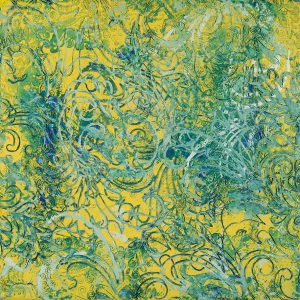 Angela White is a fine artist inspired by physical, spiritual and emotional memories that create the visual depth and density of her work. Abstracts and seascapes compose the majority of her compositions. Natural and sensual materials such as oils and encaustic paint allow the blending of edges to create visual depth. By superimposing layers of media, the varied themes and processes of her work are exposed.
Angela White is a fine artist inspired by physical, spiritual and emotional memories that create the visual depth and density of her work. Abstracts and seascapes compose the majority of her compositions. Natural and sensual materials such as oils and encaustic paint allow the blending of edges to create visual depth. By superimposing layers of media, the varied themes and processes of her work are exposed. Accumulations: Mixed Media works by Travis Childers is in the Fisher Art Gallery. Travis begins with everyday objects – newspaper clippings, staplers, pen tips and tops and transforms them into provocative objects that evoke the readymades of Duchamp and the process of the Dada movement of the 20th century.
Accumulations: Mixed Media works by Travis Childers is in the Fisher Art Gallery. Travis begins with everyday objects – newspaper clippings, staplers, pen tips and tops and transforms them into provocative objects that evoke the readymades of Duchamp and the process of the Dada movement of the 20th century.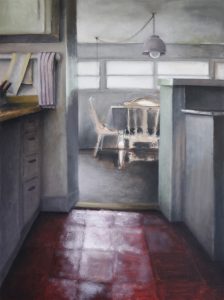 Memories of Home: Paintings by Lisa Noble is in the Passage Gallery. The interior in Lisa’s paintings are places of her past and personal history. They represent her efforts to visually map out the context of her childhood and early history.
Memories of Home: Paintings by Lisa Noble is in the Passage Gallery. The interior in Lisa’s paintings are places of her past and personal history. They represent her efforts to visually map out the context of her childhood and early history.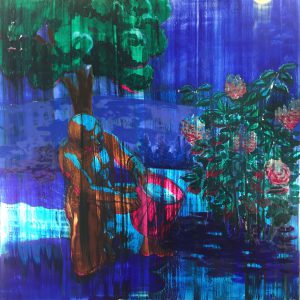 The Secret Garden: Paintings by Matt Pinney is in the Forum Gallery. Matt Pinney is an assistant professor of studio art at the Northern Virginia Community College at the Manassas Campus. Matt’s paintings employ personal myths, reinterpretations of history, and investigation of cultural assigned roles to creative narratives that are unbound by time.
The Secret Garden: Paintings by Matt Pinney is in the Forum Gallery. Matt Pinney is an assistant professor of studio art at the Northern Virginia Community College at the Manassas Campus. Matt’s paintings employ personal myths, reinterpretations of history, and investigation of cultural assigned roles to creative narratives that are unbound by time.
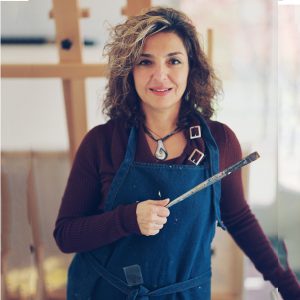 Say Behnam’s solo exhibition of paintings, Capturing the Vibrant, Transient and Eternal NOW is on display through November 4, 2018. We will be hosting a demonstration of the process that Saya uses to create her paints from plants, flowers, spices as well as stones and minerals next Tuesday October 30 12am – 2PM in the Forum Gallery of the Schlesinger Arts Center.
Say Behnam’s solo exhibition of paintings, Capturing the Vibrant, Transient and Eternal NOW is on display through November 4, 2018. We will be hosting a demonstration of the process that Saya uses to create her paints from plants, flowers, spices as well as stones and minerals next Tuesday October 30 12am – 2PM in the Forum Gallery of the Schlesinger Arts Center.